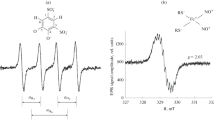Abstract
The prooxidant and antioxidant actions of Trolox were examined in anin vitro system measuring ferric ion-induced oxidation of erythrocyte membrane lipids. Trolox was found to produce a concentration-dependent biphasic effect on the ferric ion-stimulated lipid peroxidation, with the mode of action being similar to those produced by reducing-agent antioxidants, such as ascorbic acid and reduced glutathione, and iron chelator, such as desferrioxamine. Phytic acid, a potent iron chelator, could suppress the prooxidant actions of Trolox and desferrioxamine, but not those of ascorbic acid and reduced glutathione. The ability of Trolox to stimulate ferric ion-catalyzed ascorbate oxidation, as similar to the action produced by ethylenediaminetetraacetic acid, indicates the presence of iron-chelating activity. The ensemble of results suggests the possible involvement of iron chelation in the prooxidant action of Trolox in ferric ion-stimulated lipid peroxidation reactions.
Similar content being viewed by others
Abbreviations
- ASC:
-
ascorbic acid
- BHT:
-
butylated hydroxytoluene
- DESF:
-
desferrioxamine
- EDTA:
-
ethylenediamine-tetraacetic acid
- GSH:
-
reduced glutathione
- PHY:
-
phytic acid
- TBA:
-
thiobarbituric acid
- TBARS:
-
thiobarbituric acid-reactive substances
References
Scott JW, Cort WM, Harley H, Parrish DR, Saucy D: 6-hydroxylchroman-2-carboxylic acids: novel antioxidants. J Amer Oil Chem Soc 51:200–203, 1974
Mickle DAG, Li RK, Weisel RD, Birnbaum PL, Wu TW, Jackowski G, Madonik MM, Burton GW, Ingold KU: Myocardial salvage with trolox and ascorbic acid for an acute evolving infarction. Ann Thorac Surg 47:553–557, 1989
Wu TW, Hashimoto N, Au JX, Wu J, Mickle DAG, Carey D: Trolox protects rat hepatocytes against oxyradical damage and the ischemic rat liver from reperfusion injury. Hepatology 13:575–580, 1991
Wu TW, Hashimoto N, Wu J, Carey D, Li RK, Mickle DAG, Weisel RD: The cytoprotective effects of trolox demonstrated with three types of human cells. Biochem Cell Biol 68:1189–1194, 1990
Burton GW, Ingold KU: Autoxidation of biological molecules. The antioxidant activity of vitamin E and related chain-breaking antioxidantsin vitro. J Amer Chem Soc 103:6472–6477, 1981
Ko KM, Godin DV: Ferric ion-induced peroxidation in erythrocyte membranes: effects of physic acid and butylated hydroxytoluene. Mol Cell Biochem 95:125–131, 1990
Godin DV, Schrier SL: Mechanism of inactivation of adenosine triphosphatase by carbodiimides. Biochemistry 9:4068–4077, 1970
Tappel AL, Zalkin H: Lipid peroxidation in isolated mitochondria. Arch Biochem and Biophys 80:326–332, 1959
Minotti G, Aust SD: The role of iron in the initiation of lipid peroxidation. Chem Phys Lipids 44:191–208, 1987
Minotti G, Aust SD: The requirement for iron (III) in the initiation of lipid peroxidation by iron (III) and hydrogen peroxide. J Biol Chem 262:1098–1104, 1987
Loach PA: Oxidation-reduction potentials, absorbance bands and molar absorbance of compounds used in biochemical studies. In: Handbook of Biochemistry and Molecular Biology. Fasman GD (ed), CRC Press, Cleveland, 1: 3rd ed., pp. 122, 1976
Hoe S, Rowley DA, Halliwell B: Reactions of ferrioxamine and desferrioxamine with the hydroxyl radical. Chemico-Biol Interactions 41:75–81, 1982
Aruoma OI, Evans JP, Kaur H, Sutcliffe L, Halliwell B: An evaluation of the antioxidant and potential pro-oxidant properties of food additives and of Trolox C, vitamin E and probucol. Free Rad Res Comms 10: 143–157, 1990
Laughton MJ, Evans PJ, Moroney MA, Hoult JR, Halliwell B: Inhibition of mammalian 5-lipoxygenase and cyclo-oxygenase by flavonoids and phenolic dietary additives. Relationship to antioxidant and to iron-reducing ability. Biochem Pharmacol 42:1673–1678, 1991
Borg DC, Schaich KM: Pro-oxidant action of antioxidants. In: Handbook of Free Radicals and Antioxidants in Biomedicine. Miquel J, Quintanilha AT, Weber H (eds). CRC Press, Boca Raton, 1:63–80, 1989
Graf E, Empson KL, Eaton JW: Phytic acid: A natural antioxidant. J Biol Chem 262:11647–11650, 1987
Kontoghiorghes GJ: Iron mobilization from ferritin using alpha-oxohyrdoxy heteroaromatic chelators. Biochem J 233:299–302, 1986
Martell AE: Chelates of ascorbic acid. Formation and catalytic properties. In: Ascorbic Acid: Chemistry, Metabolism and Uses. Advances in Chemistry, Series 200. Seib PA, Tolbert BM (eds). Amer Chem Soc, Washington, D.C., 153–178, 1980
Halliwell B, Gutteridge JMC: Oxygen free radicals and iron in relation to biology and medicine: some problems and concepts. Arch Biochem Biophys 246:501–514, 1986
Author information
Authors and Affiliations
Rights and permissions
About this article
Cite this article
Ko, K.M., Yick, P.K., Poon, M.K.T. et al. Prooxidant and antioxidant effects of trolox on ferric ion-induced oxidation of erythrocyte membrane lipids. Mol Cell Biochem 141, 65–70 (1994). https://doi.org/10.1007/BF00935592
Received:
Accepted:
Issue Date:
DOI: https://doi.org/10.1007/BF00935592



